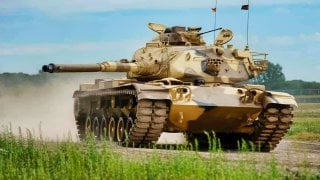M60 Patton: The Main Battle Tank Israel Loved for a Reason
During the Cold War, the M60 Patton was developed as a descendant of the M48 Patton. The M60 would serve in the armored corps of numerous American allies over the next few decades. Israel was one recipient of the M60.
Summary: The M60 tank, a U.S. Army main battle tank developed during the Cold War, surpassed its successors in longevity and versatility on numerous battlefields. It emerged as a refined version of the M48 Patton, featuring enhancements like a 105mm rifled gun barrel and significant armor upgrades. The M60A1 variant, introduced in 1960, included a new turret design and improved ammunition storage. Israel, one of the M60's recipients, used its Magach version effectively, particularly during the 1973 Yom Kippur War. The tank underwent further upgrades over the years, including Explosive Reactive Armor and advanced fire control systems, remaining in Israeli service until 2006. Despite being replaced by the Merkava series, the M60's legacy in Israel highlights its significant role in defending the country's borders against adversaries.
Why Israel Loved the M60 Tank
The M1 Abrams is widely considered the best American tank ever made. But another U.S. Army main battle tank served longer and fought on more battlefields than its successor.
During the Cold War, the M60 Patton was developed as a descendant of the M48 Patton. The M60 would serve in the armored corps of numerous American allies over the next few decades.
Israel was one recipient of the M60. Its “Magach” fleet of M60 tanks proved instrumental in defending its borders against hostile neighbors.
The History of the M60
U.S. officials after the Korean War recognized the need for a next-generation battle tank capable of countering the Soviets’ sophisticated counterparts. The M47 Patton had already entered production at the war’s outset, but delays caused by technical issues kept the platform from serving. The subsequent M48 Patton was deemed unsatisfactory, and it received upgrades in the mid-1950s.
To address apparent shortcomings in American MBTs, engineers began work on the T95 program. Designed as a more sophisticated M48 variant, the new tank featured several key enhancements. From an early, experimental X-shaped engine design to its 90mm smoothbore T208 gun, the T95 was an upgrade. However, by the time this project was being developed, an even larger gun was rumored to be in the works.
Finally, the U.S. began working on its XM60 tank in the late 1950s. This project would culminate in the M60.
Specs & Capabilities
The M60 Patton was equipped with a 105mm rifled gun barrel and a roughly six-inch-thick homogeneous steel hull for armor. Production of the M60A1 MBT series began in 1960. The tank featured a new turret and ammunition stowage system.
Over the years, several M60 variants were produced. Manufactures and sub-contractors including Raytheon and General Dynamic Land Systems specially modified the tank to better suit the needs of foreign client states. The M60A2 was developed with a 152mm gun and missile launcher. It was followed by the M60A3, which was fitted with a new fire control system.
Operational History for M60 Tank in Israel
The M60 Patton served in the U.S. Army during the Vietnam War. In the 1973 Yom Kippur War, the M60 was battle-tested in tank-on-tank warfare against Soviet platforms. During this conflict, Israel’s Magach MBTs were equipped with Explosive Reactive Armor. After the 1982 Lebanon War, Israel’s fleet of M60s was further upgraded with thermal sleeves, new fire controls, and other enhancements. The Israel Defense Forces kept Magach tanks in active service until 2006. Eventually, Israel’s homegrown Merkava series pushed these aging tanks out.
Israel’s M60 fleet may be retired, but the tanks’ honorable service record is still remembered.
About the Author: Maya Carlin
Maya Carlin, National Security Writer with The National Interest, is an analyst with the Center for Security Policy and a former Anna Sobol Levy Fellow at IDC Herzliya in Israel. She has by-lines in many publications, including The National Interest, Jerusalem Post, and Times of Israel. You can follow her on Twitter: @MayaCarlin


